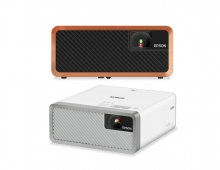
Texas Instruments Enhances DLP Technology
Texas Instruments announced a new 0.65-inch DLP chip for projectors, offering resolutions up to 1,280?768 (WXGA). The "0.65WXGA" chip takes advantage of the BriliantColor Technology, a new color-processing enhancement built upon DLP technology.
DLP Technology
Digital Light Processing (DLP) is an all-digital display chip and a key ingredient in the best digital projectors available today. DLP technology uses an optical semiconductor to recreate source material with a high fidelity. At the heart of every DLP projection system is an optical semiconductor known as the Digital Micromirror Device, or DLP chip, which was invented by Texas Instruments in 1987.
The DLP chip is a sophisticated light switch. It contains a rectangular array of up to 2 million hinge-mounted microscopic mirrors; each of these micromirrors measures less than one-fifth the width of a human hair.
When a DLP chip is coordinated with a digital video or graphic signal, a light source, and a projection lens, its mirrors can reflect an all-digital image onto a screen or other surface. The DLP chip and the electronics that surround it are what is called Digital Light Processing technology.
A DLP chip's micromirrors are mounted on tiny hinges that enable them to tilt either toward the light source in a DLP projection system (ON) or away from it (OFF)-creating a light or dark pixel on the projection surface.
The bit-streamed image code entering the semiconductor directs each mirror to switch on and off up to several thousand times per second. When a mirror is switched on more frequently than off, it reflects a light gray pixel; a mirror that's switched off more frequently reflects a darker gray pixel.
In this way, the mirrors in a DLP projection system can reflect pixels in up to 1,024 shades of gray to convert the video or graphic signal entering the DLP chip into a highly detailed grayscale image. But what about coloring?
The white light generated by the lamp in a DLP projection system passes through a color wheel as it travels to the surface of the DLP chip. The color wheel filters the light into red, green, and blue, from which a single-chip DLP projection system can create at least 16.7 million colors.
This is the part where Texas Instruments has made specific enhancements. With its BrilliantColor technology the company has added three more colors in the color wheel, resulting to an 6-color processing. Through greater flexibility in color processing, the red, green, and blue color palette is expanded with a yellow, magenta and cyan, which allow for more realistic and lifelike color reproduction. The company claims that enabling the BrilianColor technology offers a greater than 50% brightness increase in mid tone images, common in video and natural scenes.
Brilliant Color is enabled by the new DDP3020 Imaging ASIC. The technology is expected to be implemented by home theater and projector manufacturers.
The DLP 0.65 WXGA chip
The new DLP chip for 0.65-inch projectors offers a resolution of 1,280?768 pixels. The chip also features the "DarkChip2" technology that emphasizes the contrast. Mass production of the new chip set is scheduled for Q4 2005, and the first products equipped with it are expected in the beginning of 2006.
Digital Light Processing (DLP) is an all-digital display chip and a key ingredient in the best digital projectors available today. DLP technology uses an optical semiconductor to recreate source material with a high fidelity. At the heart of every DLP projection system is an optical semiconductor known as the Digital Micromirror Device, or DLP chip, which was invented by Texas Instruments in 1987.
The DLP chip is a sophisticated light switch. It contains a rectangular array of up to 2 million hinge-mounted microscopic mirrors; each of these micromirrors measures less than one-fifth the width of a human hair.
When a DLP chip is coordinated with a digital video or graphic signal, a light source, and a projection lens, its mirrors can reflect an all-digital image onto a screen or other surface. The DLP chip and the electronics that surround it are what is called Digital Light Processing technology.
A DLP chip's micromirrors are mounted on tiny hinges that enable them to tilt either toward the light source in a DLP projection system (ON) or away from it (OFF)-creating a light or dark pixel on the projection surface.
The bit-streamed image code entering the semiconductor directs each mirror to switch on and off up to several thousand times per second. When a mirror is switched on more frequently than off, it reflects a light gray pixel; a mirror that's switched off more frequently reflects a darker gray pixel.
In this way, the mirrors in a DLP projection system can reflect pixels in up to 1,024 shades of gray to convert the video or graphic signal entering the DLP chip into a highly detailed grayscale image. But what about coloring?
The white light generated by the lamp in a DLP projection system passes through a color wheel as it travels to the surface of the DLP chip. The color wheel filters the light into red, green, and blue, from which a single-chip DLP projection system can create at least 16.7 million colors.
This is the part where Texas Instruments has made specific enhancements. With its BrilliantColor technology the company has added three more colors in the color wheel, resulting to an 6-color processing. Through greater flexibility in color processing, the red, green, and blue color palette is expanded with a yellow, magenta and cyan, which allow for more realistic and lifelike color reproduction. The company claims that enabling the BrilianColor technology offers a greater than 50% brightness increase in mid tone images, common in video and natural scenes.
Brilliant Color is enabled by the new DDP3020 Imaging ASIC. The technology is expected to be implemented by home theater and projector manufacturers.
The DLP 0.65 WXGA chip
The new DLP chip for 0.65-inch projectors offers a resolution of 1,280?768 pixels. The chip also features the "DarkChip2" technology that emphasizes the contrast. Mass production of the new chip set is scheduled for Q4 2005, and the first products equipped with it are expected in the beginning of 2006.





















